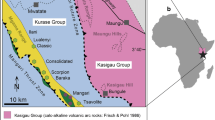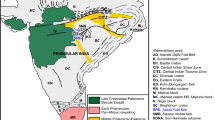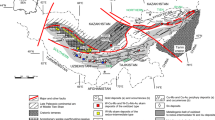Abstract
Diagenesis of the Holocene-Pleistocene volcanogenic sediments of the Mexican Basin produced, in strata of gravel and sand, 1H2O- and 2H2O-smectite, kaolinite, R3-2H2O-smectite (0.75)-kaolinite, R1-2H2O-smectite (0.75)-kaolinite, R3-kaolinite (0.75)-2H2O-smectite and R1-1H2O-smectite (0.75)-kaolinite. Smectite platelets were formed from volcanic glass by loss of Si4+. Partially-formed platelets have Si4+ between 4.55−4.10 a.p.f.u., Mg+Mn and the interlayer charge are relatively uniform while VIAl+Fe3++Ti varies between 0.98 and 1.63 a.p.f.u. Almost fully transformed platelets have Si4+ of 4.08−4.04 a.p.f.u.; Mg+Mn and the interlayer charge decrease proportionally to increasing VIAl+Fe3++Ti. Smectite-kaolinite mixed layers have octahedral occupancies of 2.01–2.15 a.p.f.u., IVAl3+ 0.09–0.55 a.p.f.u. and interlayer charges about half that of smectite; structural formulae corresponding to smectite (0.75–0.80)-kaolinite indicate octahedral occupancy of 2.50 a.p.f.u., tetrahedral replacement 0–0.31 a.p.f.u., and interlayer charge 0.24–0.51 equivalents, some indicating interstratifications of beidellite. Kaolinite is presumed to have formed from K-feldspar; smectite-kaolinite interstratifications sustain the transformation of kaolinite to smectite in an increasingly siliceous high-cation environment. In the mudstones of low-hydraulic conductivity and practically stagnant alkaline fluids, glass was transformed to 2H2O-smectite lamellae of IVAl between 0 and 0.47 a.p.f.u., octahedral occupancy 1.70–2.00 a.p.f.u. and interlayer charge of 0.23–1.21 equivalents, some corresponding to beidellite. The interlayer charge increases with IVAl and decreasing occupancy of the octahedral sheet; the abundance of Mg+Mn is inverse to that of VIAl+Fe3++Ti.
Clay suspensions containing 1H2O- and 2H2O-smectite, kaolinite and R3-2H2O-smectite (0.75)-kaolinite lead to low-energy edge-to-edge particle associations, non-Newtonian pseudoplastic behavior, and maximum apparent viscosity of 180 Pa s at 0.008 s−1 followed by rapid descent. Clay fractions with slightly larger 2H2O-smectite contents and smaller kaolinite contents reach maximum viscosity of 3611 Pa s at a shear rate of 0.0018 s−1 and of 3300 Pa s at 0.0024 s−1. They denote two high-energy face-to-face particle associations, followed by slow descent of the apparent viscosity under viscous flow. Suspensions change from elastic to viscous behavior at shear stresses of 1.03 and 5.91 Pa, respectively. Clay suspension vibrated at a frequency of 1 Hz develops a shear storage dynamic modulus greater than the shear dynamic loss modulus or the energy is preferentially stored, whereas at 5 Hz more energy is dissipated than stored.
Similar content being viewed by others
References
Almon, W.R., Fullerton, L.B. and Davies, D.K. (1976) Pore space reduction in Cretaceous sandstone through chemical precipitation of clay minerals. Journal of Sedimentary Petrology, 46, 89–96.
April, R.H. (1981) Trioctahedral smectite and interstratified chlorite/smectite in Jurassic strata of the Connecticut Valley. Clays and Clay Minerals, 29, 31–39.
Bailey, S. W. (1988a) Structures and composition of other trioctahedral 1:1 phyllosilicates. Pp. 169–188 in: Hydrous Phyllosilicates (S.W. Bailey, editor). Reviews in Mineralogy, 19. Mineralogical Society of America, Washington, D.C.
Bailey, S.W. (1988b) Chlorites: Structure and crystal chemistry. Pp. 347–404 in: Hydrous Phyllosilicates (S.W. Bailey, editor). Reviews in Mineralogy, 19. Mineralogical Society of America, Washington, D.C.
Bailey, S.W. and Brown, B.E. (1982) Chlorite polytypism: I. Regular and semi-random one-layer structures. American Mineralogist, 47, 819–850.
Barrenechea, J.F., Rodas, M., Frey, M., Alonso-Azcarate, J. and Mas, J.R. (2000) Chlorite, corrensite, and chlorite-mica in Late Jurassic fluvio-lacustrine sediments of the Cameros Basin of Northeastern Spain. Clays and Clay Minerals, 48, 256–265.
Bettison-Varga, L. and Mackinnon, I.D.R. (1997) The role of randomly mixed-layered chlorite/smectite in the transformation of smectite to chlorite. Clays and Clay Minerals, 45, 506–516.
Bodine, M.W. and Madsen, B.M. (1987) Mixed-layer chlorite/smectites from a Pennsylvanian evaporite cycle, Grand County, Utah. Pp. 85–93 in: Proceedings of the International Conference, Denver (L.G. Schultz, H. van Olphen and F. A. Mumpton, editors). The Clay Minerals Society, Bloomington, Indiana.
Brandenburg, U. and Lagaly, G. (1988) Rheological properties of sodium montmorillonite dispersions. Applied Clay Science, 124, 624–631.
Brindley, G.W. (1982) Chemical composition of berthierine — a review. Clays and Clay Minerals, 30, 153–155.
Chang, H.K., Mackenzie, F.T. and Schoonmaker, J. (1986) Comparisons between the diagenesis of dioctahedral and trioctahedral smectite Brazilian offshore basins. Clays and Clay Minerals, 34, 407–423.
Chen, J.S., Cushman, J.H. and Low, P.F. (1990) Rheological behavior of Na-montmorillonite suspensions at low electrolyte concentration. Clays and Clay Minerals, 38, 57–62.
Durazo, J. and Farvolden, R.N. (1989) The groundwater regime of the Valley of México from historic evidence and field observations. Journal of Hydrology, 112, 171–190.
Furbish, W.J. (1975) Corrensite of deuteric origin. American Mineralogist, 60, 928–930.
Gasca, D.A. and Reyes, C.M. (1977) La cuenca lacustre Plio-Pleistocenica de Tula-Zumpango. Instituto Nacional Antropologia e Historia, Informe 2, 85 pp.
Güven, N. (1988) Smectites. Pp. 497–559 in: Hydrous Phyllosilicates (S.W. Bailey, editor), Reviews in Mineralogy, 19. Mineralogical Society of America, Washington, D.C.
Heller, H. and Keren, R. (2001) Rheology of Na-rich montmorillonite suspension as affected by electrolyte concentration and shear rate. Clays and Clay Minerals, 49, 286–291.
Hillier, S. (1993) Origin, diagenesis and mineralogy of chlorite minerals in Devonian Lacustrine mudrocks, Orcadian Basin, Scotland. Clays and Clay Minerals, 41, 240–259.
Hillier, S. and Velde, B. (1991) Octahedral occupancy and the chemical composition of diagenetic (low-temperature) chlorites. Clay Minerals, 26, 149–168.
Hoffman, J. and Hower, J. (1979) Clay mineral assemblages as low grade metamorphic geothermometers: application to the thrust faulted disturbed belt of Montana, USA. Society of Economic Paleontology Mineralogy Special Publication, 26, 55–79.
Hower, J., Eslinger, E.V., Hower, M.E. and Perry, E.A. (1976) Mechanism of burial metamorphism of argillaceous sediments: I. Mineralogical and chemical evidence. Geological Society of America Bulletin, 87, 727–737.
Hutcheon, I., Oldershaw, A. and Ghent, E.D. (1980) Diagenesis of Cretaceous sandstones of the Kootenay Formation at Elk Valley (southeastern British Columbia) and Mt. Allan (southwestern Alberta). Geochimica et Cosmochimica Acta, 44, 1425–1435.
Inoue, A. and Utada, M. (1991) Smectite-to-chlorite transformation in thermally metamorphosed volcanoclastic rocks in the Kamikita area, northern Honshu, Japan. American Mineralogist, 76, 628–640.
Jiang, W.T. and Peacor, D.R. (1994) Prograde transitions of corrensite and chlorite in low-grade pelitic rocks from the Gaspe Peninsula, Quebec. Clays and Clay Minerals, 42, 497–517.
Jiang, W.T., Peacor, D.R. and Buseck, P.R. (1994) Chlorite geothermometry: Contamination and apparent octahedral vacancies. Clays and Clay Minerals, 42, 593–605.
Karpova, G.V. (1969) Clay mineral post-sedimentary ranks in terrigenous rocks. Sedimentology, 13, 5–20.
Kopp, O.C. and Fallis, S.M. (1974) Corrensite in the Wellington Formation, Lyons, Kansas. American Mineralogist, 59, 623–624.
Kübler, B. (1973) La corrensite, indicateour possible de milleux de sedimentation et du degree de transformation d’un sediment. Bulletin Centre Recherche Pau-SNPA, 7, 543–556.
Lopez-Ramos, E. (1979) Geología de México, III. Universidad Nacional A. de Mexico, Mexico.
Marsal, R.J. and Mazari, M. (1962) El Subsuelo de la Ciudad de México. Facultad de Ingenieria, Universidad Nacional A. de México, México.
Mering, J. and Pedro, G. (1969) Discussion a propos des criteres de classification des phyllosilicates 2: 1. Bulletin de Groupe Francaise Argiles, 21, 1–30.
Meunier, A., Clement, J., Bouchet, A. and Beaufort, D. (1988) Chlorite-calcite and corrensite-dolomite crystallization during two superimposed events of hydrothermal alteration in the ‘les Cetes’ granite, Vosge, France. The Canadian Mineralogist, 26, 413–422.
Mooser, F. (1956a) Vulcanismo y Rocas Sedimentarias Cuenca de México y Edo. De Morelos, Excursion C-9, XX Congreso Geologico Internacional, Universidad Nacional A. de México, México.
Mooser, F. (1956b) Informe sobre la Geología de la Cuenca del Valle de México, Secretaria de Recursos Hidraulicos, Comision Hidrologica del Valle de México, México.
Moore, D.M. and Reynolds, R.C. (1997) X-ray Diffraction and the Identification and Analysis of Clay Minerals. Oxford University Press, New York.
Newman, A.C.D. (1987) The interaction of water with clay mineral surfaces. Pp. 241–260 in: Chemistry of Clays and Clay Minerals (A.C.D. Newman, editor). Mineralogical Society Monograph 6. Longmans, Harlow, Essex, UK.
Newman, A.C.D. and Brown, G. (1987) The chemical constitution of clays. Pp. 49–63 in: Chemistry of Clays and Clay Minerals (A.C.D. Newman, editor). Mineralogical Society Monograph 6. Longmans, Harlow, Essex, UK.
Odin, G.S. (1985) La ‘verdine’, facies granulaire vert, marin et cotier distinct de la glauconie: distribution actualle et composition. Compte Rendue Academie Science Paris 301, 2, 105–108.
Odin, G.S., Bailey, S.W., Amouric, M., Frohlich, F. and Waychunas, G. S. (1988) Mineralogy of the verdine facies. Pp. 159–206 in: Green Marine Clays (G.S. Odin, editor). Developments in Sedimentology, 45. Elsevier, Amsterdam.
Pevear, D.R. and Whitney, C.G. (1982) Clay minerals in Coast Range basalts of the Pacific Northwest: Eocene seafloor metamorphism. Program with Abstracts, 19th Annual Meeting, Clay Minerals Society, Hilo, Haway, p. 6.
Reynolds, R.C., Jr. and Reynolds, R.C., III (1996) NEWMOD: The calculation of one dimensional X-ray diffraction patterns of Mixed-layered Clay Minerals. Computer Program. 8 Brook Road, Hanover, New Hampshire 03755, USA.
Roberson, H.E. (1989) Corrensite in hydrothermally altered oceanic rocks. P. 59 in: Abstracts of the 26th Clay Minerals Society Annual Meeting, Sacramento.
Ruiz-Fernandez, A. (1999) Distribucion espacial y temporal de metales pesados en sedimentos lacustres de la Cuenca de México: Chalco, Texcoco y Cuauhtitlan Izcalli, estado de México. PhD thesis, Universidad Nacional A. de México, México.
Shau, Y.H., Peacor, D. and Essene, E. (1990) Corrensite and mixed-layer chlorite/corrensite in metabasalt from northern Taiwan: TEM/AEM, EPMA, XRD and optical studies. Contributions to Mineralogy and Petrology, 105, 123–142.
Schiffman, P. and Staudigel, H. (1995) The smectite to chlorite transition in a fossil seamount hydrothermal system: The basement complex of La Palma, Canary Islands. Journal of Metamorphic Petrology, 13, 487–498.
Sistema Hidraulico del Distrito Federal (1994) Cronologia. Memoria de las Obras del Sistema de Drenaje Profundo del Dustrito Federal, Tomo I. Departamento del Distrito Federal, México.
Suquet, H. and Pezerat, H. (1987) Parameters influencing layer stacking types in saponites and vermiculites. Clays and Clay Minerals, 35, 353–362.
Suquet, H. and Pezerat, H. (1988) Comments on the classification of trioctahedral 2:1 phyllosilicates. Clays and Clay Minerals, 36, 184–186.
Suquet, H., de la Calle, C. and Pezerat, H. (1975) Swelling and structural organization of saponite. Clays and Clay Minerals, 23, 1–9.
Suquet, H., Iiyama, J.T., Kodama, H. and Pezerat, H. (1977) Synthesis and swelling properties of saponites with increasing layer charge. Clays and Clay Minerals, 25, 231–242.
Urrutia-Fucugauchi, J., Lozano, S., Ortega, O., Caballero, M., Hansen, R., Bohnel, H. and Negendank, J.F.W. (1994) Paleomagnetic and paleoenvironmental studies in the southern Basin of México. I. Volcanosedimentary sequence and basin structure of Chalco lake. Geofisica Internacional, 33, 421–430.
Van Olphen, H. (1977) An Introduction to Clay Colloid Chemistry, Interscience Publishers, New York.
Author information
Authors and Affiliations
Corresponding author
Rights and permissions
About this article
Cite this article
de Pablo-Galán, L., de Pablo, J.J. & de Lourdes Chávez-García, M. Diagenesis and Rheology of a Recent-Pleistocene Volcanogenic Sedimentary Sequence, Mexican Basin. Clays Clay Miner. 50, 807–823 (2002). https://doi.org/10.1346/000986002762090344
Received:
Revised:
Published:
Issue Date:
DOI: https://doi.org/10.1346/000986002762090344




